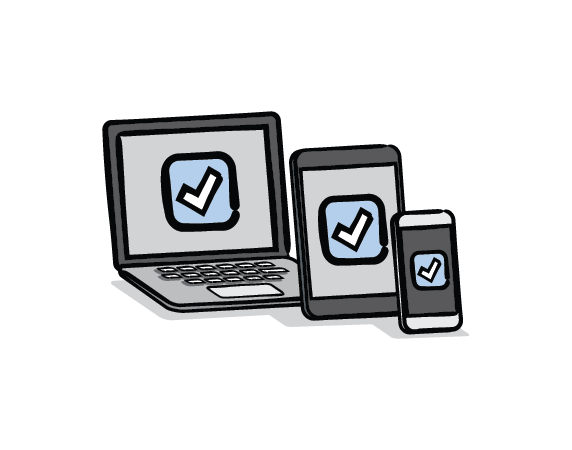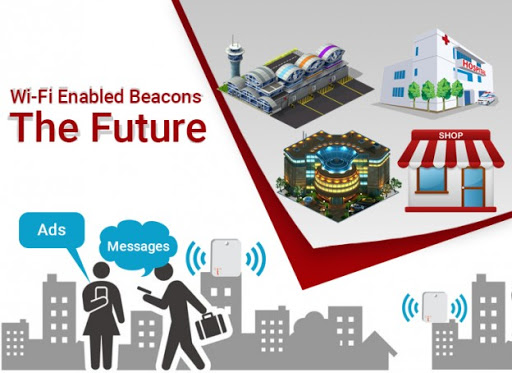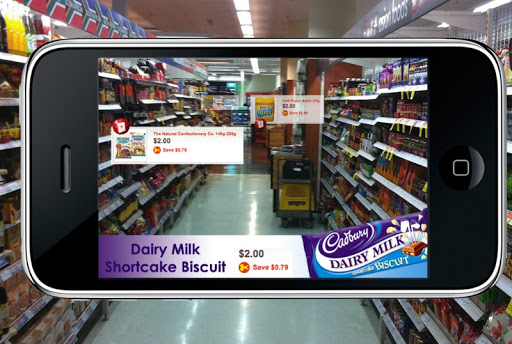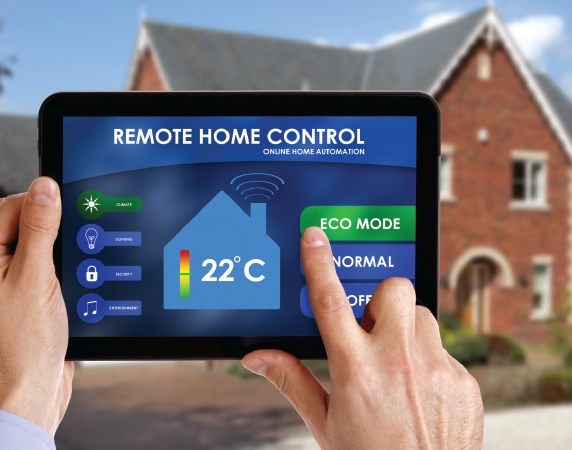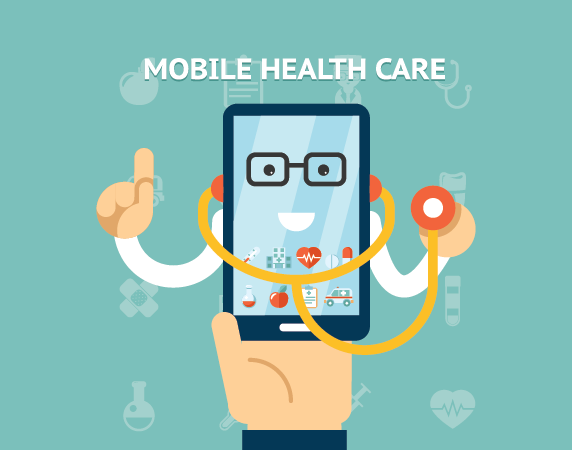Category: Mobility
We have seen the rise of certain revolutionary technologies over the past few years, like the IoT, Cloud computing and Big Data, bringing breakneck transformations throughout every industry. Being one of the greatest, irreplaceable inventions in life, the mobile industry is perhaps mostly impacted by all these emerging trends, constantly striving to bring the hottest trends at customers’ fingertips. In a short span of time, the smartphone alone has replaced the need for several other products and services, simply rendering them worthless. Not convinced?
What do you do these days when you need a dress, need to order your favorite food, hire a cab, perform a bank transaction, communicate with someone, or simply wants to entertain yourself with games, videos or social networking sites?
Grab your smartphone, right? Was this the case a few years back, when mobile phones could only place calls and send text messages?!
That’s how the mobile and mobile application industries are evolving. Today, we breathe, eat, sleep and live mobile.
So, how will be the Mobile app industry like, in the coming years? What trends will rule the smartphone application development? Let’s take a look:
More Augmented Reality, Virtual Reality based apps will come to play
AR and VR have been incredible technologies that made our lives resemble those in science-fiction movies, which once seemed impossible. AR has already revealed itself through mobile apps over the last years, from interactive map overlays to virtual showrooms. For instance, the SnapShop showroom app using AR technology lets users evaluate how particular furniture will look in their space. myNav, iOnRoad, Sky Siege are AR based mobile games already out in the market. This year we’ll see more and more businesses, from retail, e-commerce, entertainment, lifestyle to healthcare sectors creating AR based mobile apps to engage their customers and provide them better experience.
VR, though didn’t see a growth as big as AR, is not far behind. The technology that was mostly around entertainment and gaming, is now gaining momentum, with the advent of devices like the Oculus Rift, Samsung Gear VR, and Google Cardboard. The giants like, Facebook investing in Oculus VR (releasing this year) is a hint on how big its market will be.
Read more: Virtual Reality: The Revolutionary Force
Mobile Apps using Artificial Intelligence
Technology giants like, Google, Facebook, IBM and many others are investing in artificial intelligence, thus moving towards more complex computer algorithms. There are quite a few iOS and Android personal assistant mobile apps today that use artificial intelligence for smart decision making and stuff. Google Now and Apple’s Siri are apps having Natural Language Understanding (NLU), and are able to receive and understand direct instructions from the user, which according to many experts are a basic level of AI. The number of apps using AI will only increase in the years ahead.
App Security
Developers were pretty busy last year solving security issues with over 75% of apps that failed to meet even the fundamentals of security/privacy policies. Sensitive and confidential user information like, bank details and SSN become vulnerable if various apps and platforms using these fail to implement proper security protocols. The latest versions of iOS (iOS 9) and Android (Android 6.0 Marshmallow) have considered security and privacy as one of the significant parameters of app development and will continue to be of prime importance to developers.
Cross-Platform Development
Businesses are not just walking past the concept of fixed office spaces and immovable PCs or desktops, but are using varieties of smart devices, like tablets, smartphones, notes and so on, for a flexible working experience. Hence, having apps confined to be used on a single platform will become irrelevant. Apps that can be easily migrated from one platform to the other will be on demand and mobile app development will thus not confine to single platforms.
Read more: Native vs. Hybrid: Things to Know Before Building Your Next Mobile Application.
HTML 5
HTML 5 has been gaining popularity since 2014 for its ease to create hybrid mobile applications that work on multiple platforms. App developers may concentrate on building more HTML5 mobile apps (compared to Native apps) that are portable across different devices, platforms and operating systems. HTML 5 supports off-line data and rich Medias like audios and videos, making them work even when the device is offline.
Read more: Developing Native and Hybrid apps 101
Mobile Apps for 3D Printing
3D printing has been a technology that took the world by storm. With 3D printers becoming cheap and commercially available for affordable rates, the demand on mobile apps for 3D modeling and printing has increased. This year, 3D printing market is expected to rise to a trillion dollar market and we will also see smart apps focused on cloud and mobile CAD, interaction with physical world, and the like.
Beacon and Location-Based Wi-Fi Services
Wi-Fi will provide more than just internet access. Businesses will use beacon technology to understand where their customers are, and engage with them through relevant and personalized content sent to their mobile phones using the Wi-Fi. Beacon technology has reduced the gap between online and offline services in advertising and retail industries. Apple has already integrated the technology in their iOS to communicate with Apple’s iBeacon networks.
Read more: Different kinds of Beacon technologies and how iBeacons enhance customer experience.
Wearable, drones, and smart machines
The focus has shifted from consumer wearable to enterprise wearable this year. With more employees using wearables at work, businesses will require enterprise apps to manage and control efficient usage of these to increase productivity. Drones and robots were mainly limited to the locomotive industry, however, this year, a lot more robots will arrive, that consumers can really take home to simplify their daily tasks. With the drones and robots becoming common in markets, obviously we need to develop plenty of smart apps to make them work.
Read more: Wearable Technology-Dark Horse of Enterprise Workforce Efficiency?
Low Shelf Life Apps
Industries, like, Sports, Entertainment, Retail, and Media, may require apps that will work for a short period of time, until a particular event lasts or so. These are created temporarily for industries for instant gratification and needn’t last forever. For instance, companies may require apps during the FIFA world Cup season, to conduct events or reach out to the fans during that particular period of time. More industries will use such short-lived apps strategy in years ahead. Need to build such an app? Let us help.
Enterprise App Consumerization
Earlier, enterprise apps were built with strong foundation and less importance to the design. However, with more and more employees starting to use mobile devices at work, user experience has become a central factor and enterprise apps are built to look more like consumer apps. The trend has continued through 2014 and is expected to change the way enterprise software will look and will be used.
Read more: Top 5 Enterprise Application Development Trends 2016
In- App Advertising, Purchasing, and Location Based Mobile Advertising
Mobile ads will not be limited to just banners, but various other ad formats will be experimented, video ads leading the line. Studies show that in-app advertising is 11.4 times effective than standard form of banner ads. It will become more common and profound as users spent more time in mobile apps compared to website browsing, and will be a major source of revenue for app developers. This year the ads will mature further by getting the location-based technology, which will help advertisers take the relevant offers to the right customer at the right place and time.
Big Data and App Analytics
Performance tracking and decision making will become even more focused with smart data collecting and evaluating metrics in apps. Developers will concentrate on providing better performance insights to clients through data visualization and analysis. There will be thus more focus on big data and app analytics.
Smart Cities, Homes, and Offices
As more and more things get connected in the Internet of Things, there will be better ways of managing traffic, providing parking solutions, ensuring safety, connecting and controlling homes, offices, vehicles and equipment with mobile phones and so on. App developers will be really busy creating secure apps that will help people control their connected equipment remotely and safely.
mHealth
With more wearables, sensors and tracking devices getting into the medical sector, the mobile app consultations will become more matured this year. Medical field will be largely influenced by the technologies, and apps will be the binding units that will connect healthcare with IT. There will also be dedicated mobile health apps to track health of users, diagnose a variance, alert check-up etc.
Read more: Emerging Trends in Healthcare IT, 5 Pointers to Make Sure Your Healthcare Application is Future Proof, Top 5 Technology Trends Driving the Growth of Healthcare, Healthcare – Gearing up For the Internet of Things
Being one of the leading mobile app development solutions providers ourselves, we are as excited as you about the latest trends in IT, and are constantly evaluating the emerging trends and opportunities to remain the cream of the crop option for our clients. What other trends do you see rising in mobile app development in the coming years? Share your thoughts with us.
Image credits: SnapShop, think3d, bfonics.com, androidpolice, CIO
Stay up to date on what's new

Featured Blogs
Stay up to date on
what's new



Talk To Our Experts
According to Gartner, more than 50% of users will use their smartphones or tablets first for all their online activities by 2018. The fact shows how fast mobile devices are ditching the old PCs and desktops, to become the favorite smart device for users. Mobile devices could be your only desktop in coming years. As these smart devices get popular, so do the mobile apps, expanding the vast possibilities of things users can do with a small device in their hands. Almost all business brands are expanding their IT resources this year to add room for a mobile application as a part of their marketing strategies. Mobile App development has become a multi-billion dollar industry these days with endless potential and possibilities.
The popular mobile apps have always left us thinking about the richness it would have brought to its owners. Facebook, Candy Crush, Instagram, Twitter, Whatsapp and countless others have transformed apps into basic necessities for young and old equally. However, developing an amazing app is not a free process. Many people believe that their mobile application development ideas can make them quite rich very quickly if it strikes the market. It is not like the app owners receive a lot of money through their popular app that was made absolutely free of cost. App development can be a very costly affair. Many people are shocked to know that their app development could indeed cost over six figures.
The part of an application seen by its users is an extremely small part of the entire system. Application development cost is thus misunderstood or underestimated by most. But the reality is that, the big expense comes with the invisible technology- the tech that isn’t visible to users but actually runs the application. Many businesses jump into this bandwagon without realizing the true costs of mobile application development. The entire process cost will run beyond the actual development. So, what hidden costs should your business plan for developing iOS or Android mobile apps? What can be the unexpected costs that might surprise/shock you?
Here are the most common hidden charges of developing a mobile app:
1. Cost to place your apps in the app store/ Play store/market
Though not a deal breaker amount, the app stores keep your apps in it with a fee. The amount is not that huge for businesses that have decided to make the mobile app move. The fee ranges around $99 per year for Apple and Amazon App stores, one-time payment of $49 and $99 for individual and company in Windows store and a one-time payment of $25 for Google Play store. However, native app developments may confront more charges.
2. Supporting different platforms
It is surprising for many companies that do not have any previous experience of app development that they need to build mobile applications for multiple platforms and different mobile platforms will require different programming languages. For instance, you can’t make a native Android app work on iPhones and vice versa. Businesses will have to do separate IOS and Android app development, if they go for native apps. However, hybrid apps can work on separate platforms with little tweaks.
3. Web hosting, server and backend development costs
Mobile App development has mainly 2 different processes: Front-End and Back-end. The front end development is mostly what users see as the app, while the back-end is where a lot of hidden technologies make the front end work. Back end is a separately hosted Web Service or API that synchronizes information between the app and the databases. Your application will need to store its data somewhere. Web server/API hosting and your database can be hosted in a shared server/dedicated server or on cloud server based on your requirement. Cloud storage would be the ideal option as you can have the benefits of its full availability of web server/API
which, in turn provides full availability of your mobile app. However, if you are hosting your data on cloud storage, there would be monthly hosting charges that vary upon the amount of data stored and the provider.
4. Post installation cost/ support and maintenance costs
Mobile app development is not a one-time project, it is an ongoing project requiring maintenance for a certain period of time like bug fixing, security patches update, updates for the app with new and improved features, updates with OS releases, support users and more. These post-installation updates and maintenance is the real expensive part.
5. Marketing Costs
After you build an app and put it up in the store, don’t expect it to attain wings and fly off the shelves. Just because it is built better, it can’t detriment the hundreds of other similar apps and gain the crowd’s attention. The targeted audience should be able to see it, try and like it. People wouldn’t know unless you tell them about it and there is no use building a great app if no one comes to know about it. And that is where the ‘Marketing’ comes in; what follows will be the bonus- their likings, more downloads, and the ROI!
Plan proper marketing strategies/ ad campaigns to boost your sales which can, at a lower end cost around $5,000-$ 10,000 for basic PR and marketing support. It might be interesting to note that some of the industry leaders who have their app held up in the sky are spending around $100,000 plus a month to keep their apps in their current position where it will get a lot of attention. Growth Hack techniques are prevalent among SMBs today to experiment rapid popularity.
Lastly, if you dream your app should outperform today’s market, you will definitely need to upgrade from your initial budget 1.0, as we saw that costs go beyond design and coding. Depending on your preferences, there are several other tactics that can give your app a forward push, which your app development partner must be aware of, and should be discussing with you. Take part in all discussions and estimations actively with your custom software development vendor to take into account all fixed and variable costs for arriving at a precise cost estimation. At Fingent, for example, we provide our customers, detailed insights into scope, hidden cost and effort around developing web and mobile applications to be in line with their budgets.
Stay up to date on what's new

Featured Blogs
Stay up to date on
what's new



Talk To Our Experts
Field service is an industry which owes a large margin of its improvements to mobile applications. It has been leveraging mobile applications for a number of its functions and aspects for quite some time now and organizations have already replaced all of their heavy paper based processes with smart mobile applications. Most of them also continue to migrate their software as well as services and storage to the cloud, by which they allow the emails, photos, documents and other important information to be accessed from anywhere in the world.
According to a research by IDC, the world’s mobile workforce is likely to have grown to 1.3 billion this year. And the American region, including the United States, Canada and Latin America are likely to have seen an increase in their mobile workers from 182.5 million in 2010 to 212.1 million in 2015, with North America in the lead for the largest number of mobile workers at 75% of the total mobile workforce in 2010.
Such being the level at which mobile workers are increasing, there is also going to be an increase in the number of mobile devices connected to the internet, which according to Gartner is likely to be more than 30 billion in number by 2020, generating almost $2 trillion as an economic value worldwide.
That said, since mobile connectivity with the internet is rapidly increasing worldwide, it is about time that field service personnel also utilized mobile applications and start becoming a part of the mobile workforce.
As a matter of fact, the field service industry is one which has a million functions and opportunities to make them automated with mobile apps. It is indeed critical now for them to keep up with the changes and embrace mobility. Using a fully integrated field service management software has to be followed up with a mobile app as well. Read this blog to know the advantages
The field service industry actually needs mobile apps more than any industry
Field agents are almost always on the move, traveling from one job site to another. And they always need access to customer information, invoices, work order information, product or tools information and the like, most often in real-time. Since they go from one place of service to the next continuously, they might need information on their next work order and their next customer as well on the go.
A well-designed mobile app can help them simplify these processes and get things done in a more efficient and organized manner. Since it is cloud-based, it allows the field agents to pull up any information instantly from wherever they are. Hence, it avoids redundant phone calls to find the whereabouts of the agents or the job site and also any delay in information exchange.
It also helps to simplify communication between the field service agents, the providers, and the customers. Many a time, field service personnel have faced challenges in communicating with their team, especially when there are several agents traveling to a particular job site simultaneously. The right mobile app helps in effective communication and better coordination among these agents. This is especially true in case of companies that provide round-the-clock maintenance and inspection support. They definitely need a communication system that spans beyond regular telephonic calls, so that they don’t have to go through the ordeal of making a landline office phone call or enter passcodes and numbers every time that have to connect with someone. They need a system with advanced features that allow seamless communication between field service personnel.
It helps to eliminate human errors arising from manual data entry or paper-based data entry processes as well, which again adds to the effectiveness and efficiency of the organization as a whole.
Added benefits
Most field service mobile apps have many added benefits as well for the field agents, such as:
- Ability to access information related to work history and forthcoming jobs so that they can do the necessary preparations
- Ability to capture photos and signatures while they are on site
- Ability to go through and review their assigned tasks and accept or reject them according to their skills and expertise or time schedule
- An in-built navigation tool that will help them find the most efficient and appropriate route to their job site, thereby reducing travel time
- Ability to request for assistance or advice to other nearby co-workers, while they are on site and ensure that they fix the issue properly
Apart from these, there are a number of additional benefits that are designed to address the many problems that can arise in field service.
For example, there could be chances for last-minute plan or schedule changes, as technicians are always moving from one job to the next. Moreover, external factors like weather problems, traffic and power failure can also cause delay and even render the field agents from reaching the assigned location.
Field service mobile apps have advanced features to track the whereabouts of the workers in real-time and even determine the time required for him to complete a job he is currently at. Hence, the service providers can assign tasks based on the location, current job, skills and expertise of the technicians. Being cloud-based, all the team members can have access to the location of the supervisors or technicians or the customers from anywhere.
Enterprise Mobile Applications
According to a study by the Aberdeen group, “best-in-class” mobile apps are capable of completing about 1.5 times as much work on a mobile device as the industry average and also achieving an average of 40% increase in operational efficiency every year. As a matter of fact, the right mobile apps or the “best-in-class”, can do more than just mobilizing already existing enterprise software. A well-developed and a well-enforced mobile app strategy can actually act as a catalyst for improving coordination and effective communication, hastening the decision-making process and increase the overall operational efficiency of the organization as a whole.
On top of all that, as data gets collected from multiple sources and processes through mobile apps, there is also a chance of collating these and extracting greater, more useful information in the future.
Big data
Field service agents, as well as the providers have access to all information related to their jobs at one place. For the same reason, they have the opportunity to analyze and determine new trends and patterns and use it to make significant changes. For example, field agents assigned to follow up routine maintenance works on appliances and the like, can track the data collected from these works with the help of specialized mobile apps and use it to predict the next maintenance requirement. Hence, rather than fixing issues after they occur, field agents can utilize predictive analysis to be proactive in their approach.
On the whole, there are a number of unique features that mobile field service apps can provide to increase productivity and efficiency of the field service industry itself. It is high time that field service organizations (who have not already adopted mobile apps), encouraged mobility and started using feature-rich mobile applications to solve their day-to-day challenges.
Are you looking to adopt the perfect mobile solution for your field service business? Contact us to talk to our mobile application experts.
Stay up to date on what's new

Featured Blogs
Stay up to date on
what's new



Talk To Our Experts
Guess what the global population is today! It’s 7 billion and is ticking faster than the stopwatch needle. Out of this, there are more than 2.7 billion smartphone subscriptions worldwide and the figure is expected to touch 6.1 billion in 2020, surpassing the number of active fixed line connections, according to the Ericsson mobility report. By the end of 2020, 80% of the global data traffic will be from smartphones. That’s how fast people are getting the mobile mind shift.
Enterprise mobile apps: does it make sense for your business?
“Sometimes the best way to simplify complex business processes and make employees’ jobs easier is with homegrown enterprise mobile applications.”
The increased global demand in mobiles, tablets and other smart devices in the past few years have led to millions of mobile apps. The ripple effect is not just limited to the common consumers, but is also among the technology giants and SMBs, who consider that having a mobile ready team is vital for the modern work environment. 61% of companies have plans to make mobility their top priority in 2016 and will spend more on software, devices and services to accomplish this. Why? Simply because studies prove that mobile application users complete 1.5 times as much work on their smart device, that too with a 40% operational efficiency every year. Both custom mobile applications and off-the shelf business applications are getting popular among companies. Businesses are found to allow six off-the-shelf apps and five custom mobile business apps for employees on an average.
This being the status, enterprise mobile applications for businesses is not a choice anymore, rather it’s a necessity to stay relevant and in the picture. Apart from the above benefits, here are few compelling reasons why your business should start investing in enterprise mobile application development now:
Increased productivity
Enterprise Mobile apps make it convenient for workers to work. The use of enterprise mobile applications in companies are thus getting huge to collect, utilize, share and learn from their enormous amount of data. Industries (for instance, the field service industry) have been seen to embrace mobility exclusively moving from paperwork to the cloud. It has helped them simplify travel and communication, improve processes and reduce human errors. Companies have realized substantial productivity gains, improved sales, better tracking of work and least sway-offs from set goals, using efficient mobile apps. Businesses are thus going to extremes to encourage mobile application development and its adoption to make employee’s important tasks much simpler, flexible, faster and accessible on the go. It helps reduce the need for them to travel, and trims the time taken to complete tasks.
Employers are gradually shifting employees from using desktops to smart devices, because they know the workers will find it easier, faster and helps them to be in loop wherever they are. And this will in turn keep them indulged, and make them productive!
Better ROI from enterprise mobile apps
Organizations save huge amounts converting their manual processes into apps. Mobile applications encourage employee collaboration and facilitate sharing of the best practices across the teams. This helps create a holistic environment that will benefit the employer, employees and the customers. This in turn increases the ROI on a good enterprise mobile application development. . Out of those who have tracked their cost saving from switching to mobile app, 17% saved around $25,000-$100,000 annually and 81% around $1,000-$25,000.
Developing in-house enterprise applications lessens the security and risk concerns
Apps available from the stores might be too detrimental to the security. Certain apps don’t even encrypt the data they transmit/ receive through the network, and thus is prone to interceptions. Employees using such apps to store or exchange sensitive, confidential company data will be silently and unknowingly compromising the company’s security policies. Encouraging enterprise mobile app development in house is probably the right solution here.
Attracting the majority- the youngsters
The largest percentage of employees in companies is the youth, and is the most prominent users of smart devices. The generation rely more on mobile devices than on traditional PC computers. To make this vast audience satisfied and comfortable, enterprise mobility solutions is the way to go.
Greater customer engagement, service and support
Do you think you can benefit from the ability to reach out to your customers, irrespective of the place, 24*7? It’s just wow! Right? That is exactly why you will need Apps, to connect with your customers and employees anytime, anywhere.
Enterprise mobility is becoming an integral part of business. Businesses will start to own their own Enterprise App stores, and that could be the best thing to do for your company. At the same time, there are certain things that you should know before embarking on this plan so that you don’t set unrealistic goals. To ensure that enterprise app development is a strategic asset and not just another technology investment, you must align it with the company’s goals and policies. Contact our mobility experts to know more about these trends and policies, and to learn how an enterprise mobile app can change your business for the better.
Stay up to date on what's new

Featured Blogs
Stay up to date on
what's new



Talk To Our Experts
Microsoft’s Surface PRO 4 tablet is just in time, officially out since last Monday together with the Surface Book( Microsoft’s first ever laptop) and is available in the US and Canada flagship stores. “The tablet that replaces your laptop”- is how Microsoft describes its new release. Based on its pre-release hypes, it’s just natural for customers to be curious to get their hands on this sleek brand new device, but the response was too huge than predicted. The Microsoft stores were overflowing with fans and customers and we know for sure that this queue is for the new Surface devices, because not often can we see such crowd before Microsoft stores, right?!
Usually businesses are very late adopters of new devices, waiting to evaluate the device’s worth after all the hypes, post installation bugs and other manufacturing hiccups have settled down. But Microsoft’s new Surface Tablets was already pre-booked by 13 institutions from retail, financial and educational sectors, even prior to its launch. The time IDC forecasted two years before has arrived, when tablets outsell desktop and laptop PCs and when the majority (87%) of connected devices market will be tablets and smartphones.
Just in case you think this is just another passing fad, here are some research stats based on enterprise adoption of such smart devices:
- Forrester forecasts that 18% of tablet sales will be to businesses in 2017, which stresses its importance in businesses.
- By 2017, 60% of online consumers in the US and Canada will own a tablet.
- By 2018, more than 50% of users will use a tablet or smartphone for all online activities, according to Gartner.
- Studies show that tablets have seen increased adoption among employees, with more than 50% of them bringing and using their own devices or the tablets provided by companies, at least once in a week.
- A survey among mobility leaders shows that 83% of CXOs believe mobility will be among the top five digital priorities for businesses.
What we saw in front of the Microsoft outlet is just an indication of how mobile technology will rule businesses in coming years. As you can see, their numbers haven’t outgrown the number of PCs and mobiles in work spaces yet; but they still make a critical presence. And employees admit that they use these smart devices as a supplement to their laptops/PCs. Employers seem quite ready to provide smart devices to employees too, nearly one third of the companies provide tablets to their staffs at work. These portable devices, allowing immediate access to business information and resources, and running hybrid software customizable from device to device, is surging among the business workforce. This has left business managers wondering how to effectively adapt the trend to drive mobility as a part of their business technology.
The trend is forecasted to only increase in the next 5 years, though the choice of operating platforms, software and devices used at work will make the situation a bit more complex. Having access to office mail through mobile is just not sufficient for a business these days, to increase productivity and create better-informed workers. Traditional ERP system boundaries are proving to be suboptimal for meeting employee’s request for data, resources, intelligence, analytics and insights spread across different parts or groups of the organization. The employees should be able to easily collaborate and businesses should be able to seamlessly communicate with staff, without the place constraints, via integration of mobile devices, like, smartphones, tablets, PDAs and their various software and application.
Consumer technology may not be often ready for enterprise level adoption, so when different employees prefer different kind of smart devices to use at work, there arise many challenges even here, for instance,
- Most enterprise software vendors and IT departments are experts around Windows, LAMP and such old platforms. Android and iOS have a lot to learn and progress to match this, though we see them making considerable improvement nowadays.
- Certain inherent advantages of smart devices prove to be an anathema for a disciplined IT environment. For instance, the “App stores”- many IT departments remove it from smart devices for security reasons. But a policy based secure application screening is probably the right way to go.
- There is a lack of standardization working in a multi-platform environment, where plenty of popular devices stand in stark contrast, with no clear master to lead the group, unlike the desktop era, where there was windows dominance among the business PCs. For instance, Android, RIM, Windows and iOS are strong players in North America, while Symbian adds to this list in Latin America, Europe, and Asia. Similarly, different platforms, software and applications compatible for the different devices will create the situation more complex. Businesses may thus go for cross-platform applications (Hybrid applications) which can be easily deployed across the multiple platforms or devices.
With smart mobile devices, having high-end specs like, multi-core processors, high definition videos, high-resolution screen and rich yet low-cost apps in Application stores, the wireless network bandwidth consumption will be on a constant rise. The users will demand more rich media, increasing the traffic on cellular and wireless networks. Cisco reveals that the consumption of data by mobile devices will increase from 0.6exabytes in 2011 to 10.8 Exabyte in 2016; a whopping 78% annual growth rate!
Massive adoption of smart devices in enterprises and its integration in businesses is a trend that is gaining momentum and is bringing challenges, but yet, shall be here to stay as the reports show. The new paradigm shift is creating ripples around the IT ecosystem and needs a serious, thoughtful plan and response from the IT leaders.
Stay up to date on what's new

Featured Blogs
Stay up to date on
what's new



Talk To Our Experts
Gone are the days when people used to be tied to their work desks for long hours through the week and be stuck at specific places for meetings and discussions. Corporates have moved away from traditional ways of communication, both formal and informal, towards a more dynamic and versatile approach. Thanks to the concept of enterprise mobility, people can work as well as communicate with each other sitting anywhere in the world.
For a long time though, mobility has always been a part of businesses, as earlier, there were IP (Initiation Protocol) and SIP (Session Initiation Protocol) for use in office and hence were limited in scope. For advanced needs and requirements in an enterprise, mobility needs to grow and it is already starting to take new forms in the process. With the increased use of smartphones and tablets in business, enterprises are now able to increase their productivity as well as efficiency. Now, let’s take a look at the main areas where mobility is being extensively used these days:
- Sales – Whether it is an FMCG manufacturer or a financial services company, the sales team is something that is invariably always on the move. The sales representatives who work in their respective fields may face several challenges like:
– High costs of paperwork, unnecessary phone calls and visits
– Manual paper-based recording of sales order entries, which is time-consuming and error-prone
– Inability to provide demo on site to clients
– Lack of easy access to customer information
Hence, they need mobile apps that can make their work easier by improving communication access and increasing employee productivity. - Services – In services, enterprise mobility helps to reduce the cycle time, which can be a key differentiator for service providers. Cycle time refers to the time from the service request initiation to service request closure. In other words, the time starting from the beginning of your process to the end, as decided by you and your customers. For example, the time from when a customer places a phone call to the electrician, to the time he fixes the fault and closes the service request. With enterprise mobility, such phone calls and placing of service requests can be made much easier and faster.
Opportunities
The business opportunities that ensue from enterprise mobility are manifold. As mentioned earlier, it can improve the productivity of an enterprise by a large margin if implemented properly. Some of them are:
- Mobility first business processes – Enterprise mobility helps to promote competitive differentiation by providing value using a mobile first strategy to business processes creation and management. It thus adds to the efficiency of each process and in turn the efficiency of the organization as a whole.
- Knowledge management – It helps to capture explicit and tacit knowledge through the analysis of data generated from mobile devices. It also helps to provide context-based knowledge solutions.
- CYOD – Mobility promotes the latest business trend of Choose Your Own Device (CYOD) which improves employee satisfaction and that too at a reasonable IT spend.
- Productivity improvements in niche areas too – Custom-built apps hosted on the enterprise app store can support business teams working on non-commoditized processes to improve productivity and add more value.
Even though enterprise mobility is a rapidly growing phenomenon among business enterprises these days, there are certain challenges that hinder its full-fledged adoption sometimes.
Challenges to Enterprise mobility
Due to several reasons, enterprise mobility is not acceptable by some business officials and enterprises. They are:
- Connectivity – The concept of enterprise mobility revolves around the ability for employees and the management to stay connected at all times. It is all about making information available to the right people at the right time. Without connectivity, the whole concept becomes ineffective and useless.
- Devices – Devices that are being used in offices need to have the capability to deliver (and hence enable consumption) of complex information, in other words, rich media content. Rich media is a web-based terminology used in internet advertizing to describe web advertisements that utilize advanced technology like video streaming, and are also able to interact with the user immediately. For example, ads that change or react as the user’s mouse hovers over it.
- User experience – For the employees, who are used to and are experienced in traditional methods of communication, such a drastic change might not be such a welcome one. Besides, they might find it difficult to adapt themselves to the new concept, which could affect productivity.
- Security – Since with mobility, everything from backups to encryption is “on the go”, it also is quite vulnerable to loss of information. And since employees carry around their entire office in their mobile devices, losing their device means losing their office.
- Environmental sustainability – Most telecom companies use diesel to fuel their base stations and data centres. As a matter of fact, the telecom industry is one of the largest consumers of diesel. Hence, it is not quite environmentally sustainable.
However, in this fast-paced business environment, mobility is starting to be an inevitable factor for the success of businesses, whether it is accepted by employees or not. The disadvantages are often out ruled by its pros and conveniences. From the way things are, it doesn’t seem too long before it becomes a way of life.
Stay up to date on what's new

Featured Blogs
Stay up to date on
what's new



Talk To Our Experts
There were times when common banking activities like withdrawal of money or deposit of money meant time-consuming visits to the bank and waiting in line for hours. As inconvenient and troublesome as that was, it also meant less risk of being cheated and less chances of theft of personal information. Today, we have banking at our fingertips, with mobile banking applications. What we used to do in probably three to four hours earlier, can be done now with a few simple clicks or taps in a matter of seconds and that too from anywhere in the world if you have a smart device and the internet. But how secure are these mobile banking apps and online transactions? Could someone be stealing all the information you send out through such apps?
The truth is that there are various risks of being victims to such cyber attacks, but thankfully mobile banking apps these days are made with several layers of protection and it would take considerable effort for a thief to break in through all of that. Nevertheless, there are some things that you should do too, to make sure that your information is safe and protected while using mobile banking apps. Here’s what you should do for a safe banking experience online:
- Avoid following links and thus phishing – Phishing refers to the practice of acquiring personal and important information such as passwords, usernames and the like by pretending to be a trustworthy person or entity. It basically involves tricking someone into providing sensitive information and then using that information for malicious practices. It is in a way similar to actual ‘fishing’ as both of them involve bait to lure the victim into the trap. The bait in phishing could be a simple text message with an internet link or an email, or even a website, which could even look like your bank’s website (spoofing). You should never follow links on such emails and messages. According to the Federal Trade Commission, these are the most common ways that scammers use to steal private information from you. Legitimate companies and banks never ask for credit or debit card numbers, passwords or social security numbers and the like through emails and texts, so if you see a message somewhat like this:
“We suspect an unauthorized transaction on your account. To ensure that your account is not compromised, please click the link below and confirm your identity.”
DO NOT click on the link. - Download only the official banking app from a reputed site or store – Most leading banks offer their official applications on most smartphone app stores. For a fact, such apps are a lot more safe and secure than other apps and are definitely better than sending SMSs and emails. Banks actually go a long way to ensure that any information entered and sent across through their apps is encrypted. Hence make sure you download only the official app and only from leading well-known app marketplaces, like that of Google’s and Apple’s. Your bank will probably have information about their official app on their website, which you can use to verify the credibility of the app you are about to download.
- Avoid banking through public networks – Public WiFi networks are often not that secure. Even simple banking activities like checking your balance can make your private information vulnerable over the network. Most places that offer such WiFi or hotspot networks often advise their users not to share private information through it. It is always better to switch to your phone’s network in case you have to use your banking app while in a public network, as fraudsters and thieves could also be using the same network and may be waiting to steal your information. Some phones allow automatic switching to WiFi once they are in range of an open one. Hence, make sure you are not on a public network before using online banking apps or sharing any private, sensitive data.
- Avoid having personal data on your phone – For the same reason that your phone is the most convenient tool that you can easily carry around everywhere, it also proves to be sort of a risk sometimes. Your phone can have all kinds of information, like your calendar appointments, your passwords and your contacts. Such information can be read by other apps and other devices if not properly monitored and can be used against you. It also means you should be careful about where you leave your phone. Try avoiding maintaining private information on your phone as much as possible. If at all you have to, make sure you have several layers of protection for your phone. This will at least give you some time to lock your phone in case it gets stolen or lost.
- Make sure you have an updated anti-virus system – Keeping your system up to date with the latest software along with the latest security patches can actually help a great deal in keeping away malicious software and people. It is also good to download an appropriate, trusted antivirus program for your phone as well. That adds as an extra layer of protection to the phone as well.
Keeping all these points in mind, you can very well use mobile banking apps safely. All you need to do is be a little careful and alert. In spite of all this, if you happen to lose your phone, you have the Federal Laws to the rescue. According to CNN, you can recover your losses with a limit of $50 if you report the loss within two days of its discovery. Several banks apparently already have policies in place, that waive the liability completely. Even then, prevention is better than cure, so it’s always better to avoid theft and follow these simple steps while using mobile banking apps.
Stay up to date on what's new

Featured Blogs
Stay up to date on
what's new



Talk To Our Experts
Samsung, the South Korean Electronics titan, is reportedly planning to follow the footsteps of Apple. According to Forbes, the company is likely to launch a new smartphone leasing program for its Galaxy range of smartphones in the U.S market. Through this system, Samsung intends to allow its consumers avail a new mobile device, like the Galaxy S6 or the Galaxy S6 Edge on a monthly installment basis. This program is similar to the one launched by Apple less than two weeks ago.
Forbes said, “ Samsung may be launching this leasing program in the next several months, although that timeline may accelerate.”
Apple had announced its iPhone Upgrade Program in September at an event where it also launched the iPhone 6s, 6s Plus, the iPad Pro and an updated version of the Apple TV. As per the program, Apple phone users will be given the privilege of buying iPhones directly from the Apple Store, rather than through carriers. It allows users to get new iPhones every year through Apple Care, with a two-year contract starting at a very affordable rate of $32 a month. Which means, they get to upgrade each year to the latest version if they desire to do so.
Apple’s Upgrade program came at a time when U.S customers were using the lengthy subsidized plans of big wireless carriers for smartphone hardware and a result were locked in two-year contracts. Now, most customers are left with no option but to buy their own hardware, now that the wireless carriers have withdrawn. Such lack of subsidies had led to a decline in sales of high-end phones like Apple’s iPhone and Samsung’s Galaxy series. This was probably what made Apple introduce its own program to enable a larger share of its customers purchase its highly priced hardware easily. So basically, through its program, Apple makes it possible for its customers to upgrade their iPhones on a regular basis, much easily than with the traditional carrier plans and also offer better value than other similar U.S leasing programs like that of AT&T and Verizon.
Now, in the same way, even Samsung plans to make its devices easily accessible to its customers. I would say it’s a smart move as it can attract new customers who are probably looking to get a relief from two-year contracts. Even though Samsung has announced its plan to be released in the next few months, it could arrive sooner than that because the company is working hard to bring its program to the market as soon as possible. However, for the time being, Samsung hasn’t revealed its pricing strategy for the program. Hence, we will have to wait in anticipation to see what Samsung has in store.
So, now that there are two smartphone companies out to provide smartphones on lease, and since customers can hardly wait to avail them, leasing seems to be the new “in” thing. What makes it so popular? How does it benefit users and what are the disadvantages that can inhibit its adoption?
Pros and Cons of Smartphone leasing
The most important factor for the popularity of smartphone leasing is definitely the fact that there is no upfront fees required. Even though you don’t own the smartphone, you can use it for a set period of time, then give it up and upgrade to a new device. The monthly payments are also quite reasonable which makes it affordable for everyone. Also, you get frequent and sure shot upgrades, almost every year, with the option of purchasing the phone at the end of the period. Of course, it all depends on the lease plan which varies with each carrier. When you own a smartphone, you only have the option of upgrading your phone every two years. With all these benefits, more people are moving towards leasing rather than owning smartphones and spending a lot of money on them. When there is an option to rent or lease technology, people would most certainly choose to go for companies that can provide such benefits.
Although, the fact that you don’t own the device is a major con, as you need to return the phone in good condition at the end of the lease period even it is for an upgrade. The customer will be held liable for all damages which is not the case when you actually purchase a smartphone. Moreover, you can only terminate the lease agreement upon paying the balance amount of the lease and the phone.
Nevertheless, leasing is definitely becoming a much preferred and popular means to use a smartphone. Especially since the leaders in the industry are set to make it easy and affordable.
Stay up to date on what's new

Featured Blogs
Stay up to date on
what's new



Talk To Our Experts
With great power comes great responsibility. We’ve all heard of that haven’t we. Well, here is a little modified version of that – “With great benefits come great risks”. Yes, it’s true. Especially in the case of mobile payments. While we are all basking in the glory of the “great benefits” accruing from the digitization of world of payments, the flip side of things is often overlooked. How many of us know the risks associated with mobile payment portals?
Let’s just say it’s complicated. One thing to keep in mind though, is that, irrespective of what industry it is, new developments in technology mean new vulnerabilities and risks and the only way to move forward is to be well aware of them and find ways to deal with them. I’m going to take you through some risks associated with mobile payments here. Before that, let’s take a look at how mobile payments work.
How does it work
Mobile phones contain a Near Field Communications (NFC) chip inside, which stores the bank information or debit/credit card information securely. NFC is a short-range wireless technology used for communication between various digital devices. When a consumer makes a purchase, the NFC chip transmits the relevant information through wireless technology, as the consumer enters the range of a retail register. It is similar to the Radio Frequency Identification Technology (RFID) used in contactless credit cards and transit cards.
Risks involved
First of all, the GSM or CDMA standards used by the service payment providers may be the primary cause of risks or vulnerabilities. Many service providers often use messaging protocols along with their data transmission systems for the sake of convenience or ease. But they fail to provide the required level of security encryption, which makes it easy for frauds to break in and steal important information, like for example payment authentication information.
Another issue with mobile payments is shoulder surfing and device theft which involve spying on the users of cash-dispensing machines or any other electronic devices and obtaining their Personal Identification Number (PIN) or passwords and the like. Sometimes such spying can take place even through malware like malicious programs, viruses, and other such invasive software. This risk can be avoided through an appropriate antivirus software or by using trusted sources for downloading applications.
The Point of Sale (POS) terminal device used by NFC technology in mobile payments is another risk. These terminals may get hacked and can be used within probably a distance of 20 centimeters from your device. This increases the chances for other malware to be uploaded onto your device, which in turn leads to fraudulent NFC transactions in the same name. Such risks can be minimized by having a bilateral system authentication before making a mobile payment. It also helps to keep away from false payment requests. As a matter of fact, the source of the payment request needs to be checked properly for its genuineness, as it is a clear indicator of a risk.
Then there are regular risks associated with payments as well, like the chances of someone else’s expenditure being charged to your account or the same purchase being charged twice to your account and the like. Such risks arise irrespective of whether you swipe a card to make a purchase or whether you make contactless payments.
Mobile payment basically brings with it a lot of risks along with benefits and conveniences. A major concern of the people regarding mobile payments is having to disclose a lot of personal information in order to make purchases easier. Such information, once fed into a mobile wallet stand the chance of being used by other applications in your mobile device as well, if not properly protected. Most of the time, people ignore the permissions page while downloading an app and grant permissions to Apps straightaway without reading them. Sometimes, it doesn’t even make sense for apps to request permission to access certain information that is clearly not necessary for it to function. But we tend to overlook this in the urge to install applications that we find interesting, without even knowing how our private data can get compromised through such apps. It would help to read through these once before installing apps so as to minimize the risks of your personal details being shared.
Stay up to date on what's new

Featured Blogs
Stay up to date on
what's new



Talk To Our Experts
As the reign of mobile applications and mobile devices continue, we, as part of this revolutionary trend, have to keep ourselves updated about everything latest in the mobile world, don’t we? Of course we do. We also have to be aware of everything we need to in this regard. I’m talking about mobile applications and their making. Continuing my endeavour to make you guys acquainted about the many processes and resources that go into making a mobile application, here I’m going to give you some more information on mobile application testing.
In one of my previous articles, A winning mobile testing strategy: The Way to Go, I had explained the various steps involved in the process of testing and the article, and Mobile Application Testing: Challenges and the Solution had the major challenges faced by testers.
Now, for those of you who read through the testing process, in case you are wondering “what other kinds of testing are there?”….
Here is a list of the most commonly used kinds of mobile application testing. Do keep in mind that all of these tests are conducted to perfect different aspects of an application. Hence, ideally a combination of some of these would probably be the best way to go.
- Functionality testing – This is actually the most basic kind of testing for any application, as it ensures that the basic functions of the app work as intended. As is the case with any user interface based application, mobile applications work on the basis of several human interactions as well. All of these functions need to be tested for their accuracy. Considering the challenges faced by testers, like the wide range of mobile devices for example, functionality testing is usually a time-consuming and intensive process if it is done manually. However, there are various automation tools available in the market for functional testing as well.
- Usability testing – This is conducted in order to ensure that the mobile app is easy to use and provides a good user experience to the customers. It basically tests the app from three angles:
Satisfactory user experience – The user acceptability level or comfort level of the application and also others affected by its use.
Effectiveness – The level of benefits achieved through the app in comparison to the level of resources expended for it.
Efficiency – The accuracy of the application in terms of its ability to achieve specific goals in specific environments. - Performance testing – This covers testing of performance of the application from the client side, server side as well as network. The client side will focus more on things like, responsiveness of the application, user interface elements etc. It also involves testing with different types of data connections, WIFI, levels of battery consumption etc. There are again a number of tools available to carry out testing in these areas.
- Compatibility testing – This is conducted to see whether the application works as intended in different devices, Operating systems and their different versions, browsers and screen sizes.
- Security testing – This is carried out to test whether the application is capable of storing and protecting information.
- Memory testing – This is important to ensure that the application maintains optimum memory usage throughout its life. Mobile devices usually tend to have very limited memory and the operating systems also have a tendency to stop applications that use too much memory, which might lead to problems with user experience.
- Regression testing – This is done in order to bring to light any bugs or errors that may exist in already built modules of a project after making changes such as improvements, enhancements or configuration changes and the like.
There are also other kinds of testing, like services testing, user interfaces testing, operational testing etc. which are also done in some cases depending on the kind of mobile application. Apart from that, the most commonly used tests are listed above. As a general rule, functional testing is often conducted first followed by performance testing and the rest. Like i said before, not all of these tests might always be conducted in order. It all depends on the application. The basic point is that testing is a huge and significant part of mobile application development, and at no cost can this be avoided.
Stay up to date on what's new

Featured Blogs
Stay up to date on
what's new






